See also
- Shibutani
- Shibuya Fifteen , a 2005 Japanese television drama
- Kōza-Shibuya Station, a train station on the Odakyū Enoshima Line, Japan
Shibuya is one of the 23 special wards of Tokyo, Japan. Named after it are:

Shibuya is a special ward in Tokyo, Japan. A major commercial and finance center, Shibuya houses two of the busiest railway stations in the world, Shinjuku Station and Shibuya Station.

Harajuku is a district in Shibuya, Tokyo. Harajuku is the common name given to a geographic area spreading from Harajuku Station to Omotesando, corresponding on official maps of Shibuya ward as Jingūmae 1 chōme to 4 chōme. In popular reference, Harajuku also encompasses many smaller backstreets such as Takeshita Street and Cat Street spreading from Sendagaya in the north to Shibuya in the south.

The East Japan Railway Company is a major passenger railway company in Japan and is the largest of the seven Japan Railways Group companies. The company name is officially abbreviated as JR-EAST or JR East in English, and as JR Higashi-Nihon in Japanese. The company's headquarters are in Yoyogi, Shibuya, Tokyo, and next to Shinjuku Station. It is listed in the Tokyo Stock Exchange, is a constituent of the TOPIX Large70 index, and is also one of the three only Japan Railways Group constituents of the Nikkei 225 index, the other being JR Central and JR West.
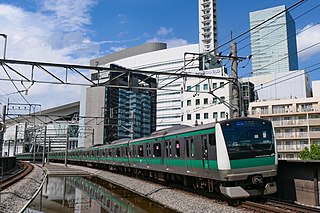
The Saikyō Line is a Japanese railway line operated by the East Japan Railway Company. It connects Ōsaki Station in Shinagawa, Tokyo, and Ōmiya Station in Saitama Prefecture. The line's name is a portmanteau of the two areas the line connects: Saitama and Tōkyō.
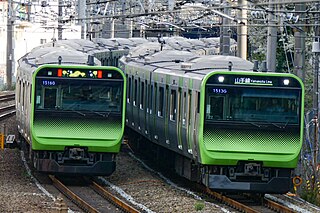
The Yamanote Line is a loop service in Tokyo, Japan, operated by the East Japan Railway Company. It is one of Tokyo's busiest and most important lines, connecting most of Tokyo's major stations and urban centres, including Marunouchi, the Yūrakuchō/Ginza area, Shinagawa, Shibuya, Shinjuku, Ikebukuro, and Ueno, with all but two of its 30 stations connecting to other railway or underground (subway) lines.

The Tokyo Metro is a major rapid transit system in Tokyo, Japan, operated by the Tokyo Metro Co. With an average daily ridership of 6.84 million passengers, the Tokyo Metro is the larger of the two subway operators in the city; the other being the Toei Subway, with 2.85 million average daily rides.

The Tokyo Metro Ginza Line is a subway line in Tokyo, Japan, operated by Tokyo Metro. The official name is Line 3 Ginza Line. It is 14.3 km (8.9 mi) long and serves the wards of Shibuya, Minato, Chūō, Chiyoda, and Taitō. It is the oldest subway line in Asia, having opened in 1927.

Shibuya Station is a major railway station in Shibuya, Tokyo, Japan, operated jointly by East Japan Railway Company, Keio Corporation, Tokyu Corporation, and Tokyo Metro. With 2.4 million passengers on an average weekday in 2004, it is the fourth-busiest commuter rail station in Japan and the world handling a large amount of commuter traffic between the city center and suburbs to the south and west.

The Tōyoko Line is a major railway line connecting Tokyo (Shibuya) to Yokohama. The line is owned and operated by the private railway operator Tokyu Corporation. The name of the line, Tōyoko (東横), is a combination of the first characters of Tōkyō (東京) and Yokohama (横浜), and is the mainline of the Tokyu network. The section between Den-en-chofu and Hiyoshi Station is a quadruple track corridor with the Tōkyū Meguro Line.
Ebisu, also transliterated Yebisu, may refer to:

The Tokyo Metro Hanzōmon Line is a subway line in Tokyo, Japan, owned and operated by Tokyo Metro.

Hachikō was a Japanese Akita dog remembered for his remarkable loyalty to his owner, Hidesaburō Ueno, for whom he continued to wait for over nine years following Ueno's death.
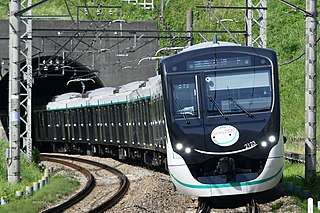
The Den-en-toshi Line is a major commuter line operated by the private railway operator Tokyu Corporation and connecting south-western suburbs of Tokyo and neighbouring Kanagawa Prefecture, with its western terminus of Chūō-Rinkan, to a major railway junction of western downtown Tokyo, Shibuya. At Shibuya, nearly all the trains continue on the Tokyo Metro Hanzomon Line.

The Keio Inokashira Line is a railway line operated by the Japanese private railway operator Keio Corporation in the western suburbs of Tokyo, connecting Shibuya in Tokyo with Kichijōji in Musashino City. It is not physically connected to the Keio Main Line Network, but a transfer is available at Meidaimae Station. This line is 1,067 mm gauge, unlike other Keio lines which are 1,372 mm gauge.

Daikan-yama Station is a railway station on the Tokyu Toyoko Line in Shibuya, Tokyo, Japan, operated by the private railway operator Tokyu Corporation.
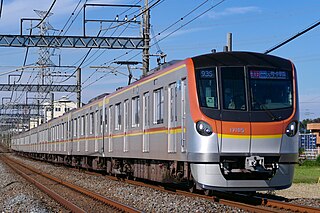
The Tokyo Metro Fukutoshin Line, formally the No. 13 Fukutoshin Line, is a 20.2-kilometer (12.6 mi) subway line operated by Tokyo Metro in west-central Tokyo and Wako, Saitama, Japan. The newest line in the Tokyo subway network, it opened in stages between 1994 and 2008. On average, the Fukutoshin Line carried 362,654 passengers daily in 2017, the lowest of all Tokyo Metro lines and roughly one third of its sister Tokyo Metro Yūrakuchō Line (1,124,478).

The Shibuya River is a river which flows through central Tokyo, Japan.

Honmachi (本町) is a residential district of Shibuya, Tokyo, Japan.
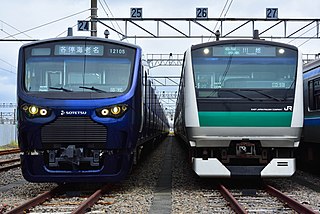
The Sōtetsu–JR Link Line is a section of the Eastern Kanagawa Rail Link project, built by the Japan Railway Construction, Transport and Technology Agency (JRTT). It connects the Sōtetsu Main Line to the JR East Saikyō Line, via the tracks of the Sōtetsu Shin-Yokohama Line and the Tōkaidō Freight Line. This service is publicly referred to as a Sotetsu Link Line by JR East, and as a JR Link Line by the Sagami Railway.